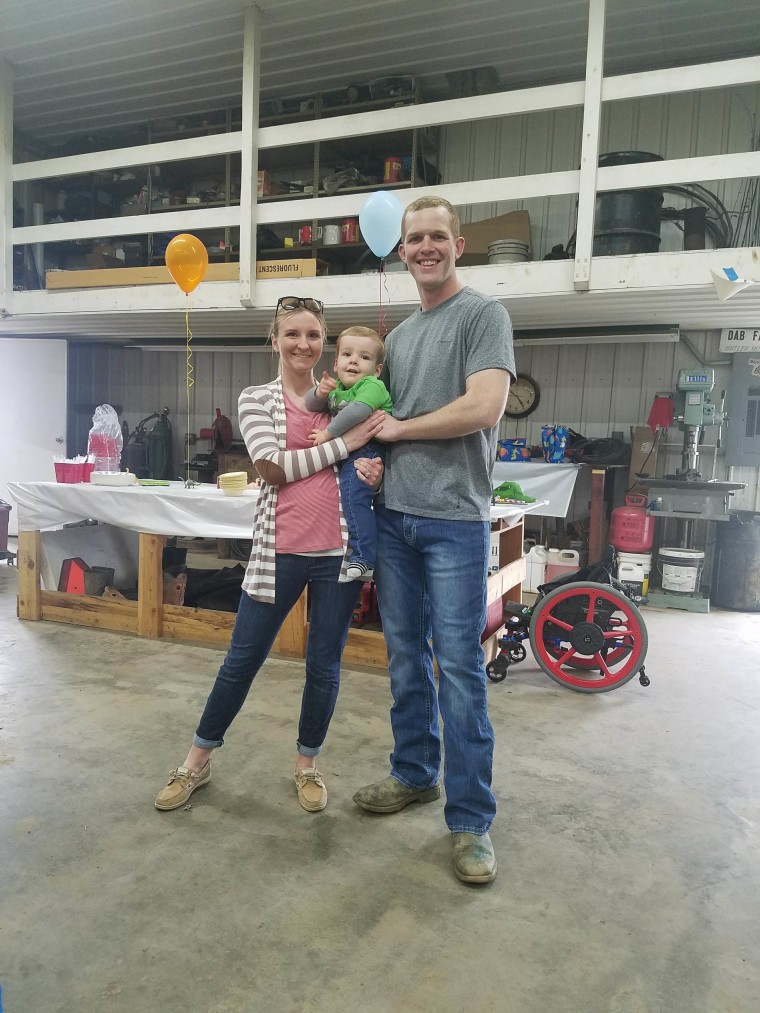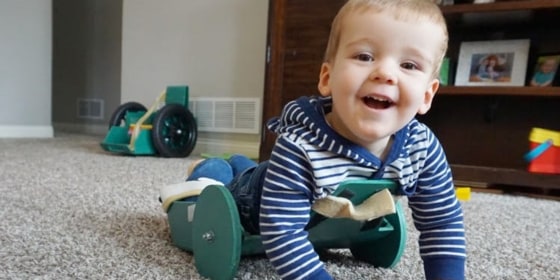At 2 years old, Brody Moreland likes to “destroy” his family’s house, getting toys everywhere and exploring with the speed of a mischievous toddler. It’s exactly the way his parents wanted it to be.
They credit “The Frog,” a homemade device Brody’s dad created to help him get around on his own. The family now wants to share it with the world.
“Brody started getting into trouble, getting into things he shouldn’t have been getting into — that was great because we wanted that so bad. We wanted him to get into trouble just like any other little boy would,” Taylor Moreland, 28, who lives in Centralia, Missouri, told TODAY.
Brody was born with spina bifida, a birth defect that occurs when a baby’s spine doesn't form normally in the womb. After doctors discovered the condition 20 weeks into Ally Moreland’s pregnancy, they gave the couple a 50/50 chance that their firstborn would be able to walk.

Right after birth, Brody underwent back closure surgery and skull surgery to drain extra fluid from his brain. Four more surgeries followed in the next six months.
But his mobility didn’t improve: He’s basically paralyzed from the chest down, Moreland said. He has arm control, but no trunk control.
“At first, I thought so negatively about all the things that he wouldn’t be able to do. That’s kind of where your mind goes,” Moreland recalled.
“That lasted for about a week. After that it was like, what does it matter? In today’s day and age, anybody can be happy, anybody can be successful, there’s so much opportunity and possibility.”

As Brody grew, playtime meant spending time on his belly on the floor. He pushed up with his arms, but couldn’t crawl, so he’d stay in exactly the same place where his parents placed him. When Brody turned 1, the family tried a ZipZac baby wheelchair, which he took to well, but it still wasn’t a solution since he couldn’t easily reach the ground where his toys were.
It was important that Brody be able to crawl and play on the floor, just like other toddlers. It was just a matter of finding a way. So the family tried to put him on a scooter board — a plastic board with wheels at the bottom — but he'd get his hands caught underneath it and it wasn’t comfortable if he wanted to put his head down on the ground.
Taylor Moreland, who runs a business selling seeds and other crop products, started “tinkering around.” He has no official design experience, but grew up on a farm where he helped his dad make anything that was needed.
After about a month, “The Frog” was ready for Brody to try. It supports his body with the help of large wheels placed near his hips. It tilts up and down so he has to carry some weight in his arms just like any other baby would when crawling. When he’s tired, he can comfortably rest his head on the floor. The large wheels mean he can easily roll through carpet or over a transition in a doorway. The patent is pending.
The device is an excellent idea, said Elizabeth A. Fain, director of occupational therapy at Pfeiffer University in Misenheimer, North Carolina, who was not involved in its design and offered an independent opinion.
It promotes increased shoulder strength and stability, plus increased head and trunk control, she noted. It also boosts visual perceptual skills and cognitive skills.
“The design of the Frog enables the child to be secure on the device and be more independent for exploring, which is needed for achieving various developmental tasks,” Fain told TODAY.
“I hope that they are able to move it forward to the commercial market.”

The device has been “life-changing” for Brody, his parents said. He can chase the cat, open drawers, play with his cousins, explore on his own and “be crazy like any toddler should be,” his mom noted.
Since he’s started to explore on his own, Brody has become more curious and has started talking more, his dad added.
“It was so great to see his little mind working on its own. He would go get the toys he wanted to play with and he would come rolling up to us and ask us something… we look over and he’s gone. Where did he go?” he said, laughing.

Moreland has now produced Frog devices for 20 kids and there’s a growing waiting list of orders. He creates them at home using a computer numerical control (CNC) machine that cuts out the shape from light, rigid plastic based on his design. The Frog works for kids ages 6 months to 3 years. Moreland is working on a larger version for kids up to 6 years old.
The Frog costs $300, but the family is raising money so that they can donate the device for anyone who needs it.
“To see your little one do something you never thought was possible is pretty fun,” Moreland said, adding the family has been overwhelmed by the attention. “Brody now rolls around saying, ‘I’m famous’ all the time.’”












